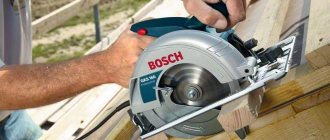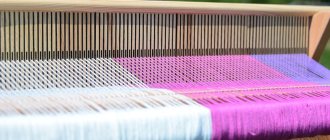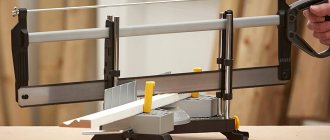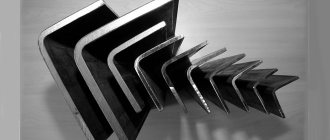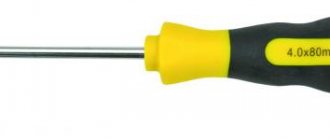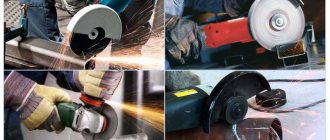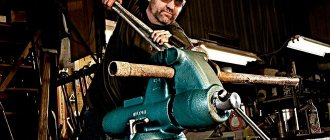One of the simplest and most recognizable locksmith tools is a screwdriver. Its design is simple, as is its scope. However, there are several types of tools, some of which are necessary to have in every home, while others are useful only to highly specialized craftsmen.
Types of screwdrivers
Screwdrivers are divided into types according to the type of slot. The standard marking and its explanation are indicated next to the name of the form.
Flathead screwdriver - SL or slotted
Other names are straight or straight spline. The shape of the working part is a flat blade.
- Suitable for simple screws with one notch.
- Manufacturers additionally indicate the length, thickness or depth of the groove if the tool is intended to be used for work with specific fasteners.
- A slotted screwdriver is most often used for simple electrical fastenings.
- The disadvantages of flat models include the impossibility of centering - the bit tends to slip out of the screw.
The force is applied to the opposite (diagonal) outer edges of the slot.
Phillips screwdriver - PH or Phillips
Cone shaped bit with four edges for Phillips fasteners.
- The Philips cross profile is characterized by two grooves located at right angles to each other.
- This option offers a number of advantages over the classic flat shape - more points of contact, increased working contact.
- The force is applied along the four edges - screwing is less labor intensive.
- Disadvantage: Since the force is applied in a narrow area, there is a risk of damaging the screw or spline.
The Phillips profile is often confused with Pozidriv. Improper use can cause damage and rapid wear of the tool.
Hexagonal - H or HEX
These models or inbuses are recognized by their working part with a hexagon-shaped cross-section. Compared to a simple cross model, the torque can be increased up to 10 times.
There are three variants of HEX models:
- Internal - the protrusion is located inside and is intended for fastening screws that have a corresponding recess. A shape with six sides that are at an angle to each other.
The disadvantage is an increased concentration of stress, leading to deformation of the fasteners.
- External - protrusion along the rim, used for fasteners with non-recessed heads. Can be used as an alternative to a wrench. This option is also hexagonal in shape with six sides.
They stand at an angle of 120 degrees to each other.
- Vibration-proof - the model has a hole in the tip of the bit that matches the shape of the protrusion of the screw head. This ensures stability and protection from vibrations.
The functionality of all three types is identical.
Square – Robertson, Square Head
- Section in the shape of a square.
- Four surfaces at right angles to each other.
- Opposite sides are parallel.
- Due to the small disk area, the profile is ineffective for transmitting large torques.
This model is rare in Russia, practically absent in Europe, but widespread in the United States. In addition to standard applications, it is used in the mechanics of vintage cars.
Cross-shaped with guides - PZ or Pozidriv
The Pozidriv profile is produced in the form of two crosses, offset at an angle of 45 degrees for tight insertion into the fastener.
- The additional cross is narrower than the main one and less deep. This provides additional stability and stability.
- Pozidriv is an improvement on the classic Phillips profile.
- Four additional edges or rays besides the cross profile serve to push the tip out.
- The cross slot has a recess for the guide.
- It fits into the fastener more tightly than a simple cross shape.
There is a hole in the middle of the slot to increase the pressure force, but it does not eliminate the disadvantages of the classic cross-shaped design.
Star-shaped - TORX
A tool with grooves shaped like a six-pointed star.
- Used to transmit increased torque compared to classic variations.
- The spline or screw is not damaged during operation.
- There is no danger of the tool slipping, as sometimes happens with a flat profile.
- Reduced radial forces extend tool life. This is the result of a combination of the circular geometry of the spline lobes, the sidewalls and the 15 degree drive angle.
Please note the differences between TORX and TORX PLUS: they are designed for different fasteners, despite identical functionality and external similarity. TORX PLUS has flattened petals rather than rounded ones. This is a strengthened version of the model.
Vibration-proof TORX has the same properties as classic TORX. The difference is that the tool has a hole located in the tip, and the corresponding screw head is complemented by a small central pin.
Basic provisions
Just like several centuries ago, a screwdriver consists of three main elements: a handle, a rod and a tip. The handle of all screwdrivers is almost the same, the main properties that it should have are: ease of holding in the hand, strength of the material and, necessarily, impediment to electricity. As for the rod, it can be of different lengths, depending on the inaccessibility of the fastening element that needs to be tightened or unscrewed. The tip has many variations, depending on the type of fastener to which the tool will be applied. The following types of tips are distinguished:
- Flat . The oldest type of standard tip, considered the most common. The tip is made in the form of a narrow straight plate and is used when replacing door handles, sockets, repairing electrical appliances, and so on.
- Cross-shaped . It is also no less common type than the flat tip. It is made in the form of a cross with four equally spaced edges. Thanks to its spline arrangement, this type of tip has improved adhesion to the surface of the fastener, allowing you to unscrew and tighten elements with better effect. It is used in self-tapping screws for wood and metal, in motorcycles and cars, and in household appliances.
Cross improved . It is made in the same form as a regular cross, but has additional slots placed between the main ones, one for each span. In this way, an even greater effect of tightening bolts and screws is achieved. It is widely used in fastening furniture products.- Hexagonal . This tip is made in the shape of a regular hexagon. Due to the tight contact with all the walls in the slot of the fastening element, the maximum effect is achieved, which is superior in efficiency to the cross tip. Used on furniture screws (confirmant), bicycles.
- Six-pointed . It is a hexagon with pointed corners and is used for small bolts in mobile phones and other complex devices.
- Square . An equally common type of tip, most often used in computer technology.
- Triangular . This type of tip is made in the form of a triple slot, resembling a triangle with blades equidistant from each other. Used in household kitchen appliances. Easily replaced with a flat-head screwdriver of the required width.
Characteristics
The characteristics of a tool can be read by its full markings. For example, SL1*80 is a flathead screwdriver with a 5mm diameter blade, 80mm long, suitable for fasteners with a diameter of less than 3mm.
| Number | Rod Ø | rod length | Ø fastener |
| №0 | 4 mm | less than 80 mm | less than 2 mm |
| №1 | 5 mm | 80–100 mm | 2.1–3 mm |
| №2 | 6 mm | 100–120 mm | 3.1–5 mm |
| №3 | 8 mm | 120–150 mm | 5.1–7 mm |
| №4 | 10 mm | 150–200 mm | 7.1 mm and more |
In combination with the type marking (SL, HEX, PH, etc.), the table gives a complete picture of the characteristics and application features of a particular tool. Sometimes the marking is supplemented by an indication of the metal alloy from which the slot is made.
Screwdriver functions
Screwdrivers are equipped with additional sets of options, which are selected according to the type of work and requirements for the tool.
Electric installation work
The priority is protection against electric shocks and detection of electrical wiring.
- Dielectric coating is a tool for working with live wiring. Electrical insulation can withstand up to 1000 volts. Most often, such models are accompanied by red markings.
A dielectric screwdriver can be covered with a layer of insulation along the entire length of the rod up to the slot.
- Tester, probe - a device is built into a screwdriver that can detect hidden wiring and the presence of current in the outlet. When a voltage source is detected, the tool emits a light or sound signal.
The indicator screwdriver signals when the upper part is clamped with a characteristic glow. More often, these models are produced in transparent cases.
Difficult operating conditions
To access hard-to-reach places, unscrew rusty fasteners or carry out long-term large-scale work, special tools or improvised means are used.
Some screwdriver models have features that make working in difficult conditions easier. There are no universal options; the tool is selected for a specific task.
- Hard-to-reach places - screwdrivers with a flexible shaft are used for easier access. Most often, such models provide additional reinforcement, a spring frame or a magnetic bit.
- Processing tight fasteners - most often, difficulties are caused by corrosion, which firmly adheres the screw to the surface. For such tasks, models are used that can withstand the impact of a handy tool (hammer, chisel).
The impact screwdriver is equipped with a metal body and handle. When the auxiliary tool hits the end, the screwdriver slot rotates.
- Long-term work - most often these are processes that require repeated twisting of fasteners. To simplify the work, reversible screwdrivers with a ratcheting mechanism are used.
If you need to screw in more than ten bolts, use a mini-analogue of a screwdriver - a cordless screwdriver.
Different types of fasteners
For work with non-uniform fasteners, models with a bit change function are used. If you have to work with flat and cross-shaped fasteners at the same time, combo models are preferable.
Most often, this is a handle with an insert rod on which various types of bits are attached. Flipping the shaft in combo models turns the cross bat into a flat one. Another option is a permanent rod with a magnetic holder for a replaceable slot.
For diverse jobs, it is often not a specific model that is chosen, but a set of screwdrivers. It is a small case or suitcase containing several screwdrivers or just one - a basic one and a set of replacement bits for it.
Equipment
The features of the splines are discussed in detail above, so we will focus on the remaining components of the kit - the handles and rods.
Handles
Handles are made of plastic or polycomposite. To reduce slipping, a rubber coating, recesses or notches are used. The coating makes the tool ergonomic and comfortable.
- The ratchet mechanism is an attachable ratchet handle similar to those used in compound socket wrenches. During operation, the rod and tip rotate freely, and the handle remains motionless in the hand.
The model does not require unnecessary movements, therefore it is optimal for large-scale work.
- T-shaped - Swivel type models with a curved or solid top that supports the installation of an auxiliary arm.
- With a heel - most often found in impact screwdriver sets. Instead of recessing into the handle, a through stroke is used. The rod at the end free from the nozzle has a thickening - a heel, which softens the load from blows with a hammer.
Modified handles make screwing/unscrewing easier or increase torque. Most often, functionality is set by a button or reverse switch on the handle.
Rods
Shaft modifications allow you to add additional functionality to the tool.
- Non-standard length - elongated or shortened models of screwdrivers. Length restrictions apply to the shaft and handle. Suitable for processing hard-to-reach places. More often found in combo or flexible models.
- With a tip change function - the tool in this configuration is equipped with a ratchet mechanism or a standard handle. The option without a mechanism involves the use of a universal combo rod. For splines of such models, the kit includes replacement bits.
- Faceted rod - option with a square or hexagonal cross-section (standard - round). Supports the use of leverage to add torsional force. The lever is the tool at hand.
Bits and sockets are typical bit attachments.
There are magnetic models that support the grip of fasteners in inconvenient conditions. External parameters correspond to standard types of splines.
Base material
Modern screwdriver handles are made from various types of plastic and thermoplastic rubber. Gone are the days of wooden and all-steel handles. The most common today are solid one-component and two-component handles. Impact-resistant types of plastic are used as the basis for both.
Often, for a decorative effect, two-component handles are made of transparent plastic, although more often opaque plastics are used as a base. Transparency/opacity of the plastic base of the handle does not affect performance characteristics.
Accessories
There are no individual accessories for screwdrivers. They are complemented only by kits that combine diverse types of attachments or screwdrivers.
Such a kit often consists of a housing with recesses for convenient placement of basic and spare parts.
- Small or budget kits are small plastic cases.
- Professional models - a suitcase with a handle for comfortable carrying, plastic or rubber-coated.
Inside contains a set of screwdrivers, replaceable heads or bits.
The larger the set, the more variations there are for different types of work, sizes and shapes of marks.
There are models supplemented with protective agents - anti-corrosion liquid, oil for lubricating metal elements, and a cleaning brush.
Rechargeable models are complemented by a charger and a replaceable battery. Household variations often do without these accessories - the buyer independently takes care of timely charging.
Overlays or additional covering
If in one-component handles there are no other materials besides the base, then in two-component handles there is a second surface material or lining. Their task is to increase friction between the hand and the screwdriver and create a certain shock absorption.
The anti-friction coating can either cover almost the entire area of the screwdriver or take the form of separate linings in the planes most loaded with friction. The best option is thermoplastic linings. With a similar coefficient of friction, they absorb shock vibrations better than conventional rubber. Consequently, the hand will get less tired.
Peculiarities
The features of screwdrivers are considered in relation to the type of tool slot.
By slot type
- Flat - the tool tightens standard screws and screws, markings are marked along the width of the tip. Suitable for fastening with cross marks. Flat models are used for household and electrical installation needs.
- Hexagonal - for fasteners with hexagonal notches. Variants of a non-standard type are common, representing an L-shaped rod with edges, bent at the top.
The thickness of the rod corresponds to the slot of the fastener for which it is suitable.
Used for repairing electrical equipment and assembling furniture.
- Star-shaped - used in the repair of household appliances and mobile phones. They are rarely used in everyday life, as they require special skills.
- Cross-shaped ones are the most convenient for household and professional needs. There are models that support combination with a flat slot. Optimal for tightening all types of self-tapping screws and screws of suitable shape.
There are special models for narrow applications, adapted for use with only one or several types of fasteners:
- Spanners are two-pin variations for elevators with anti-vandal protection.
- Trefoils (Tri-Wing) - for aviation and complex electronics.
- Asymmetrical (Torq-Set) - aircraft industry only.
- Clutch - for Chevrolet and GMC trucks.
- Pentalobe is a pentagonal version for Apple technology.
These models are not used in everyday life, but without knowledge of their existence, repairing complex equipment is not always possible.
Screwdriver tip
The main working part of a screwdriver is its tip. It is also sometimes called “sting”. To ensure that the tool lasts a long time and does not cause trouble, when choosing a screwdriver, take a closer look at the tip. First of all, you should visually examine the quality of metal processing on the tip. Edges and surfaces must be carefully milled and sanded. There should be no burrs or scuffs.
If you know in advance which slotted screwdriver you are going to buy, take a sample of fasteners with you to the store. A well-processed tip should fit tightly and without play into the internal profile of screws and screws.
Pros of screwdrivers
The advantages of screwdrivers are based on the configuration and functionality. A convenient set of options does not always replace specific functions.
Basic advantages of options:
- electric models or battery type - increased operating speed;
- with reverse - support unscrewing of fasteners;
- ratchet - minimal load on hands;
- impact - cope with tight screws that a regular screwdriver cannot twist;
- indicator - the ability to determine the phase, search for live wires;
- dielectric - safe for electrical installation work, preferable when it is not possible to de-energize the room.
The advantages are usually combined. For example, a dielectric coating is combined with an indication option, and a battery is combined with reverse.
Problems
Disadvantages that complicate operation are also associated with the set of functions. The fewer additional options a screwdriver has, the higher the chance that the tool will last a long time.
Problem areas:
- Rechargeable type - requires constant changing or charging of batteries. In conditions of major renovation of the premises, it quickly breaks down. More often this feature is found in Chinese technology, the quality of which does not always meet the needs of Russian conditions.
- Ratchets are sensitive to abrasives and dust. The mechanism fails when used in dusty areas or at a construction site.
- Drums are unsightly due to their metal casing; ergonomic models of this type are rare.
- Indicator - the main problem is the indicator light burns out, after which the model turns into a regular screwdriver. An audible indication requires changing batteries.
The current charge is not displayed on the case, so at the right time it is easy to find yourself without the corresponding functionality.
Models with reverse are not included in the list of problems, since the mechanism rarely fails. Dielectric variations are similar to ordinary ones, the only difference is in the coating, so their operation does not cause problems.
Additional options
In addition to the basic structural elements, screwdrivers from some manufacturers are equipped with additional options that make their everyday use more convenient or add new functions to the tool.
The hole in the handle increases the comfort of use, allowing you to hang the screwdriver on a tool stand or simply on a nail in the wall.
The slot for power rotation adds the ability to increase the force with a wrench. As a rule, a similar option is present in power screwdrivers.
The hammer head on the back of the handle allows you to use a hammer in your work. In some cases, when there is no special concern for the tool, a screwdriver with a hammer head can be used as a drift, a punch, or even a chisel for stone.
It is important to remember that the service life of a screwdriver depends not only on the integrity of the manufacturer, but also on your correct choice of tool for the task.
How to choose a screwdriver
The screwdriver is selected in accordance with the tasks ahead and the type of fastener you plan to work with.
The following parameters will tell you about the quality of the tool:
- The strength of the rod is indicated on the body. A tool with a strength value in the range of 47–52 Rockwell units is preferred. An indicator below the indicated one indicates the likelihood of bending, and above it indicates a tendency to cracking.
- Alloy - Cr-V or chrome vanadium is considered universal. It maintains sufficient mechanical strength.
- Equipment : ergonomic rubberized handles are preferred. The tool should not slip out of your hands, even if they are wet. It is advisable to select bits with magnetic coating for comfortable work with small fasteners.
For tools from Russian manufacturers, compliance with GOST 17199–88 is provided. In this case, there is a marking on the body or handle.
Screwdriver shaft
The rod takes on mechanical load during rotation. This task gives rise to requirements for types of steel, the quality of which directly affects the characteristics of the rod. How the rod behaves as the torque applied to the screwdriver increases.
Screwdrivers that can be found in retail sales mainly have shafts made of carbon, chrome vanadium (Cr-V), chrome-molybdenum (Cr-Mo) steels, as well as S2 and SVCM steels.
The most affordable is carbon steel. Its only advantage is the low price of the tool.
Chrome vanadium steel is the most common material for screwdriver rods. It has sufficient plasticity, but under high loads Cr-V is irreversibly deformed.
Some manufacturers use chrome-molybdenum steel, which is usually used for pliers (pliers, wire cutters, etc.). The alloy withstands shock loads well, but resists torsion loads poorly.
One of the best steel options for a screwdriver is S2 alloy steel. It contains molybdenum and silicon. S2 resists load well, but breaks down when the limit is reached. Due to its low plasticity, it has a low threshold for reversible deformation. Sometimes you can find S3 steel as an improved version of S2.
Ultra-modern development of steelmakers SVCM steel. Its composition is selected specifically for the needs of screwdriver production. SVCM combines the advantages of Cr-V and S2 steels - hardness, rigidity, ductility and a high threshold for reverse deformation.
Exploitation
The greatest danger when working with a screwdriver comes from improper use of the tool.
- Before starting work, select the appropriate type of screwdriver and make sure that the size of the working area matches the size of the fastening profile.
- When working, you must use it only for its intended purpose, do not heat it to temperatures higher than permissible, and do not use a screwdriver whose tip is damaged.
- The handle must be insulated and free of chips if work is carried out under voltage.
- The screwdriver shaft must be positioned along the axis of the fastener.
Guarantee
Hand tools come with a warranty that ranges from 12 months to lifetime service.
- The need to exchange goods or return money arises if the purchased screwdriver turns out to be defective, deteriorated or broken due to the fault of the manufacturer.
- Refusal to receive warranty service occurs in case of non-compliance with the rules for using the tool or in case of mechanical damage.
The budget segment allows people not to contact service centers, but to buy a new tool.
Malfunctions
Screwdriver malfunctions in their basic form are limited to broken handles or dull metal slots.
- If the handle is replaceable, it is replaced with an analogue one. Models with solid handles must be recycled. However, craftsmen fix broken plastic by heating or using superglue.
In this case, the durability of the repaired handle is not guaranteed; the tool is no longer suitable for screwing in self-tapping screws and tight bolts.
- A dull screwdriver is sharpened using a grinder and a cutting wheel, a Dremel or a needle file. The last option is the most labor-intensive. Sharpening a screwdriver with a disc requires fixing it at an angle of 90 degrees to create correct bevels.
Self-repair is only possible if the battery is dead or the ratchet is clogged. If the mechanism becomes clogged, the tool is disassembled, cleaned of abrasives and lubricated for prevention.
Models with complex mechanics are more often subject to repair under service conditions.
Screwdriver manufacturers
FIT
Budget tool supplier from China. The company itself is located in Canada. They offer a large selection of hand tools. The warranty is for power tools only and is equal to 1 year.
Gross
German brand, the tool is produced in China. They have impeccable quality, reliability and ergonomics that meet European standards for work at a professional level. Warranty – 1 year.
Hama
A German company that produces tools and accessories in various industries. They provide a huge selection (more than 17,000 items of goods). Warranty terms are not specified.
JONNESWAY
Manufacturer of professional tools from Taiwan. Products are made from high quality materials according to generally accepted standards. It is used in enterprises with high equipment requirements. Lifetime warranty on products.
Makita
A Japanese manufacturer specializing in household appliances and tools, manufactured in China. Quality and durability are confirmed by a lifetime guarantee and an international quality certificate.
Stanley
The company is based in the USA and the instruments are made in Taiwan. They specialize in hand tools for professionals and amateurs. The main qualities of the products are innovation and convenience. Manufacturer's standard warranty is 1 year.
STAYER
A young Russian manufacturer specializing in the production of budget tools, power equipment, and thermal equipment. The company's products are famous for their high quality and long service life. The warranty on tools is 5 years.
Wiha
World leader in the manufacture of premium hand tools. They produce more than 3,000 types of tools that are famous for their quality and functionality. Warranty – 2 years.
The history of this tool
As you understand, each tool has its own history, and, in fact, a screwdriver is no exception. The very mention of a screwdriver appeared back in the 16th century. It is clear that in those days it was completely different from the instrument that is available now. However, a more modern and high-quality screwdriver appeared at the end of the 17th century, and it had a special groove to make it more convenient to tighten.
As for Phillips screwdrivers, they appeared quite recently, and to be more precise, in 1936. Just imagine, Phillips screwdrivers are actually less than 100 years old today. The patent for the invention of such a screwdriver belongs to the American Henry Phillips. In the 40s, sacral fasteners were very often used in the creation of military equipment, in particular military aircraft.
Currently, there are about 10 different types of this tool, but not all of them are used, as they say, on a daily basis.
Let's talk a little about the types of screwdrivers.
